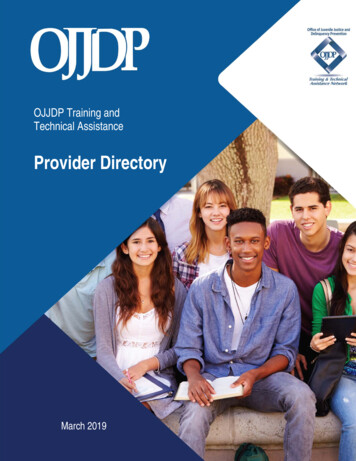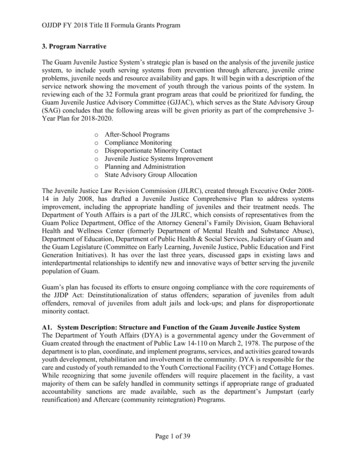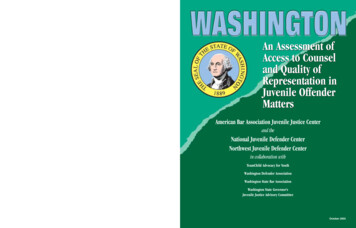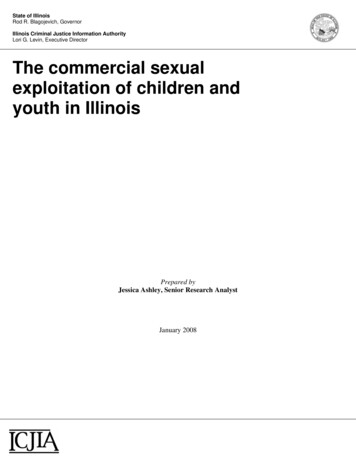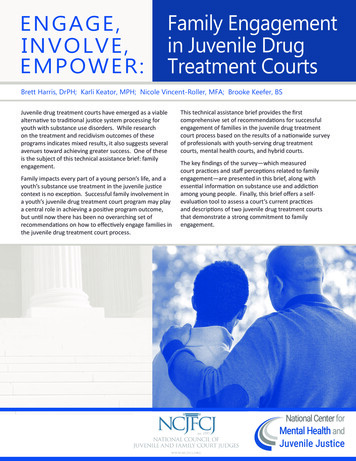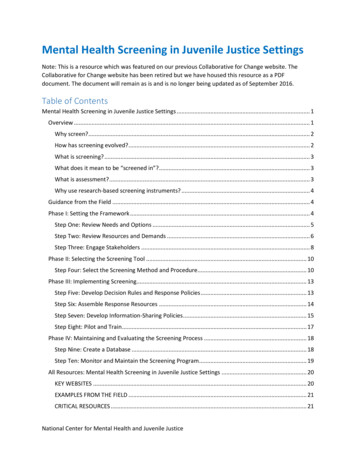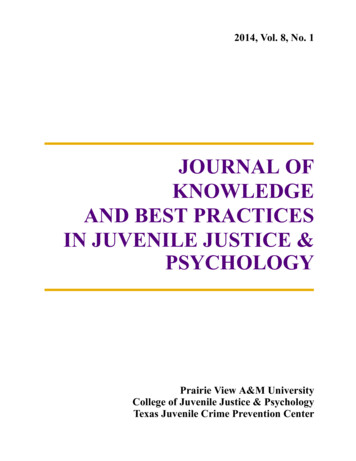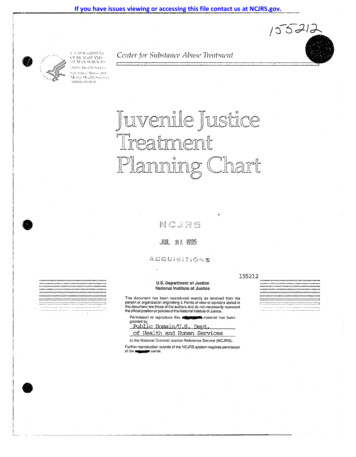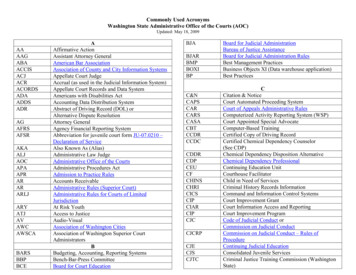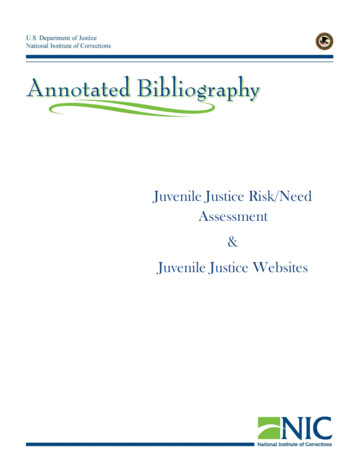
Transcription
OJJDPJournal of Juvenile JusticeVolume 3, Issue 1, Fall 2013
Editor in Chief:Monica L. P. Robbers, PhDmrobbers@csrincorporated.comAssociate Editors:Eve Shapiroeshapiro@csrincorporated.comMargaret Bowenbowen1@peoplepc.comDeputy Editors and e-publishing: Kimberly TaylorStephen ConstantinidesAdvisory Board:Janet ChianconeCatherine DoyleBrecht DonoghueEditorial Office:CSR Incorporated2107 Wilson Blvd., Suite 1000Arlington, VA 22201Phone: 703-312-5220Fax: 703-312-5230Journal website:www.journalofjuvjustice.orgISSN: 2153-8026Peer ReviewersDr. Stephanie Ellis,Marymount UniversityDr. Lisa Lunghofer,MANILA Consulting, Inc., VirginiaDr. Lia Ahonen,Örebro UniversityDr. Anne Dannerbeck Janku,Missouri Office of State Courts AdministratorMr. James Seward,Hennepin County Sheriff, MinnesotaDr. Tracy Keaton-Johnson,Norfolk State UniversityDr. Deborah Schiavone,Howard University School of NursingDr. Tammy Garland,The University of Tennessee ChattanoogaMs. Sandra Davie,Department of Youth Services, Lane County, OregonDr. Holly Hills,University of South FloridaMaj. Thomas D. Perks,Salvation Army Massilon, OhioDr. Marta Makarushka,Oregon Research InstituteDr. Julie Singer,Governor’s Crime Commission of North CarolinaCriminal Justice Analysis CenterMr. William Patton, J.D.,Whittier School of Law, Southern CaliforniaDr. Catherine Reed,The Dibble InstituteMs. Lisa Thurau,Strategies for YouthOJJDP Journal of Juvenile JusticeDr. Elena Broaddus,Johns Hopkins Bloomberg School of Public HealthMs. Stacey Bates,Pflugerville Independent School District, TexasDr. Chenelle Jones,Ohio Dominican University
OJJDPJournal of Juvenile JusticeTable of ContentsPAGEARTICLEiiiForewordBrecht DonoghueDeputy Associate Administrator of Innovation and Research, OJJDP1The Impact of Juvenile Mental Health Court on RecidivismAmong YouthDonna M. L. Heretick and Joseph A. RussellStrategies for Solutions Consulting, Arvada, Colorado15Gender-Specific Mental Health Outcomes of a Community-BasedDelinquency InterventionAshley M. Mayworm and Jill D. SharkeyUniversity of California, Santa Barbara36Predicting Recidivism Among Juvenile Delinquents: Comparison ofRisk Factors for Male and Female OffendersKristin C. Thompson and Richard J. MorrisUniversity of Arizona, Tucson, Arizona48Building Connections Between Officers and Baltimore City Youth:Key Components of a Police–Youth Teambuilding ProgramElena T. Broaddus, Kerry E. Scott, Lianne M. Gonsalves, Canada Parrish,Evelyn L. Rhodes, Samuel E. Donovan, and Peter J. WinchJohns Hopkins Bloomberg School of Public Health, Baltimore, Maryland63Internet-Based Mindfulness Meditation and Self-regulation: ARandomized Trial with Juvenile Justice Involved YouthMichelle Evans-Chase, University of Pennsylvania, PhiladelphiaOJJDPVolume 3, Issue 1, Fall 2013
PAGE80OJJDPARTICLEAssessing Youth Early in the Juvenile Justice SystemAnne M. Hobbs and Timbre Lee Wulf-Ludden, University of Nebraska, OmahaJenna Strawhun, University of Nebraska, Lincoln97A Jury of Your Peers: Recidivism Among Teen Court ParticipantsBrenda Vose, University of North Florida, Jacksonville, FloridaKelly Vannan, University of Central Florida, Orlando, Florida110Commentary: Place-Based Delinquency Prevention: Issues andRecommendationsJeffrey J. Roth, Indiana University of Pennsylvania, Indiana, PennsylvaniaOJJDP
ForewordHistorically, the state and local response to delinquency has focused on strategies and tactics as they pertain to the system and its agents—law enforcement,the courts, corrections, and affiliated agencies. Today, a growing body of researchon adolescent brain and behavioral development, philanthropic advocacy, andpressing fiscal realities are fueling efforts in states and communities across thecountry as they rethink their response to juvenile offending. Recognizing that anevidence-based approach must guide innovation and reform, OJJDP supportsresearch that informs juvenile justice policymakers and practitioners about whatworks, what is worth further exploration, and how to improve existing delinquency prevention and intervention responses.Significant new scientific findings are expanding what we know about the processes of growth and maturation that are ongoing during adolescence. Simplyput, adolescents are on the path to adulthood, but this transitory period betweenchildhood and full maturity presents its own unique challenges for the juvenilejustice community. Adolescents are not yet adults, nor should we treat them thatway when they offend. Our responsibility to our children is to help them successfully navigate the difficult process of growing up so that they become fully contributing members of their communities. Because violence and trauma can oftenderail positive development of too many young people, it is important that weexamine and discuss the issues that hinder their potential and work to get theirlives back on track for healthy growth and wellness.The Journal of Juvenile Justice is a critical component in OJJDP’s efforts to supportthe infusion of evidence into policy and practice and to ensure that our partnersin the field have ready access to the latest juvenile justice research and evaluationfindings. In this issue, we present articles on a study of the effects of one juvenilemental health court on recidivism, an evaluation of gender-specific mental healthoutcomes of a community-based delinquency intervention program, and a studyof whether male and female offenders have differing risk factors for recidivism.Other articles examine a Baltimore team-building program to improve interactions between police and middle school students, the impact of Internet-basedmindfulness meditation and guided relaxation on helping incarcerated youthself-regulate, whether formal processing diversion programs or assessments thatscreen low-risk youth out of the system are effective against recidivism, and theeffectiveness of teen courts on recidivism. The Journal closes with a critique of“hot spot” policing on delinquency prevention.OJJDP Journal of Juvenile Justiceiii
The juvenile justice field is currently undergoing a great period of innovation andreform. OJJDP publishes the Journal of Juvenile Justice to share and lend a criticaleye to the exciting developments that are taking place in communities across thecountry. Our goal is to spark an ongoing conversation about how we can betterserve our children and point to possible ways forward. We hope that you find thisissue of the Journal helpful and thought provoking.Brecht DonoghueDeputy Associate Administrator of Innovation and ResearchOffice of Juvenile Justice and Delinquency PreventionivOJJDP Journal of Juvenile Justice
The Impact of Juvenile Mental Health Court onRecidivism Among YouthDonna M. L. Heretick and Joseph A. RussellStrategies for Solutions Consulting, Arvada, ColoradoDonna M. L. Heretick, president, Strategies for Solutions Consulting; Joseph A. Russell, research associate, Strategies for Solutions Consulting.Acknowledgments: Appreciation is extended to Mr. Jeff McDonald, Coordinator of the First JudicialDistrict Mental Health Court (SB94), for the opportunity to work on this important project. Mr.McDonald is a person with dedication and vision, qualities shared by others who are involved in allaspects of the Juvenile Mental Health Court program.Correspondence concerning this article should be addressed to: Donna M. L. Heretick,Strategies for Solutions Consulting, 10455 West 85th Place, Arvada, Colorado 80005. E-mail:donna heretick1@juno.comKeywords: juvenile justice, mental health court, recidivism, program evaluationAbstractAs many as 70% of youth who enter the juvenilejustice system are diagnosed with mental disorders. In 2009 alone, 1.54 million juveniles werearrested. Recidivism rates for these youth can beas high as 52%. Juvenile Mental Health Courts(JMHCs) in conjunction with Intensive SupervisedProbation (ISP) is one initiative that addresses thespecial needs of these juveniles; however, there islimited outcome research with meaningful datacomparing juveniles with and without accessto JMHCs. This study employed a retrospectiveobservational design to compare the recidivism outcomes of 81 youths (ages 10 to 17) whoentered a JMHC in Colorado between 2005 and2011 with recidivism outcomes for juveniles whoentered a JMHC in California during the sametime period. This study also compared the outcomes of juveniles in Colorado who were adjudicated and assigned to other forms of probationand diversion, and juveniles in the same statewho were diagnosed with a mental disorder andassigned to intensive supervised probation, butwho do not have access to a JMHC. Youth in theexperimental group (i.e., those with access to theJMHC) showed significantly decreased recidivismrates during and following their probationaryperiod than those in the comparison groups.Average time to reoffending for youth whocompleted JMHC successfully exceeded 1 year,with a significant reduction in violent/aggressive and property offenses. This article examinesoutcomes and includes recommendations for thefuture evaluation of JMHCs.IntroductionIt is estimated that as many as 70% of youth whoenter the juvenile justice system are diagnosedwith one or more mental disorders (Hammond,2007). To put this figure into perspective, approximately 1.54 million individuals under age 18were arrested in the United States in 2009 alone(U.S. Census Bureau, 2012). While precise recidivism rates for this population are often difficultto determine (Roberts & Bender, 2006; Snyder& Sickmund, 2006), McReynolds, Schwalbe, andOJJDP Journal of Juvenile Justice1
Wasserman (2010) have estimated a recidivismrate of 52.8% for these youth.affects outcomes for youth (Callahan, Cocozza,Steadman, & Tillman, 2012).Mental Disorders Among YouthThe JMHC attempts to meet the needs of juvenileoffenders while protecting public safety. Variousmodels of JMHCs have been implemented; evaluation of their effectiveness is ongoing. JMHCs follow the tradition of other diversion programs foryouth, which are based on the philosophy thatfor certain youth, involvement in the courts andinstitutions is counterproductive to rehabilitation(Center on Juvenile and Criminal Justice, 1999;Wales, Hiday, & Ray, 2010).Definitions of mental disorders among youth andadolescents in the juvenile justice system generally have followed criteria established by theAmerican Psychiatric Association’s Diagnostic andStatistical Manual of Mental Disorders (DSM-IV;APA, 2000). The most common diagnoses forthese youth are disruptive disorders (46.5%),especially conduct disorder, followed by substance use disorders (46.2%), anxiety disorders(34.4%), and mood disorders (18.3%). Even whensubstance use disorders are not included, fully61.8% of youth in the juvenile justice systemmeet criteria for at least one, and often more,mental disorders (Shufelt & Cocozza, 2006).Juvenile Mental Health CourtsJMHCs are voluntary diversion programs thatadhere to a paradigm of therapeutic jurisprudence, following a “nonadversarial, treatmentoriented approach when adjudicating juvenileoffenders, while still upholding their dueprocess rights” (Office of Juvenile Justice andDelinquency Prevention, OJJDP, n.d., para. 6).JMHCs rely on cooperation and collaborationamong members of a multidisciplinary teamwho work with and for the benefit of the youthand the family. Similar to mental health courtsfor adults, JMHCs have two main goals: first, todecrease recidivism; and second, to increaseparticipants’ adherence to treatment (McNiel &Binder, 2007).The youth’s and family’s compliance with treatment is essential to the effectiveness of JMHCs.The definition of treatment compliance foryouth is broader than it is for adults, and mayinclude not only follow-up and adherence totreatment for health and mental health concerns, but expectations in relation to the youth’sbehavior in school and within the family. Inaddition, the family is expected to comply withthe JMHC program, since their compliance also2OJJDP Journal of Juvenile JusticeBetween 1977 and 1979, researchers in Coloradopilot tested an early diversion program that provided individual, parental, and/or family counseling to a general sampling of 848 youth who werediverted from processing in the formal juvenilejustice system (Pogrebin, Poole, & Regoli, 1984).Although not a juvenile mental health court,youth in this initial demonstration diversionprogram had significantly lower recidivism ratesthan a control group of youth who proceededthrough the juvenile justice system as usual(Pogrebin et al., 1984). Many successful diversionprograms, not specific to youth diagnosed withmental disorders, have followed the methodsdetailed in that study (Center on Juvenile andCriminal Justice, 1999; District Attorney Jefferson& Gilpin Counties, CO, 2012).Early JMHCs were introduced in 1998 in YorkCounty, Pennsylvania; in 2000 in MahoningCounty, Ohio; and in 2001 in Santa Clara County,California. By early 2012, there were approximately 50 JMHCs in 15 states, either in operation or in the planning stages. Ohio, with nine,and California, with eight, are the states with thegreatest number of JMHCs. Other states, such asColorado, Illinois, and Idaho, have one to two districts with JMHCs (Callahan, et al. 2012; SAMHSA’sGain Center, n.d.).Pre-Release and Post-Release RecidivismRecidivism, generally defined as reoffending, isclassified by the Colorado Division of Probation
Services (2010) according to two types: prerelease recidivism/failure and post-release recidivism. Pre-release recidivism, which occurs whilethe individual is on probation, is defined as “anadjudication or conviction for a felony or misdemeanor, or a technical violation relating to acriminal offense, while under supervision in acriminal justice program.” Post-release recidivismis defined as, “a filing for a felony or misdemeanorwithin 1 year of termination from program placement for a criminal offense” (Colorado Division ofProbation Services, 2010, p. vii). Both status andnonstatus offenses are included in these definitions. A “status” offense is one which, under thecurrent law, would not be a crime if committedby an adult (e.g., truancy or curfew violations;Colorado Division of Criminal Justice, 2011a).Evaluations of Mental Health CourtsAs Cocozza and Shufelt (2006) note, most of theevaluations of mental health courts have focusedon those for adults. Recent studies of adultmental health courts have included comparison groups, as well as pre-post designs. Resultsindicate that they are effective both in reducingrecidivism and in increasing the use of mentalhealth services (Callahan & Wales, 2013).By comparison, fewer outcome studies haveevaluated the effectiveness of JMHCs, especiallywith viable comparison groups using post-participation recidivism rates (Cocozza & Shufelt,2006; OJJDP, n.d.). One of the few that has beenevaluated is California’s Santa Clara County Courtfor the Individualized Treatment of Adolescents(CITA; Behnken, Arredondo, & Packman, 2009).The CITA evaluation compared offense patternsof youth before they entered CITA with theiroffense patterns and frequency of offenses during their time in the program. The researchersfound a significant reduction in recidivism duringthe youths’ participation in CITA. However, theresearchers did not have information on a viablecomparison group or on post-release recidivismpatterns (Behnken et al., 2009).A more recent report on California’s AlamedaCounty Juvenile Collaborative Court (ACJC;National Center for Youth Law, NCYL, 2011) offersinformation on retrospective data (case files) for34 participants (29 successful completers) whoattended between 2007 and 2009. Their reportincludes patterns of offenses, and needs and usesof mental health and other services, for a periodprior to the youths entering ACJC, during theirparticipation, and for up to a year following participation. In addition, interviews and surveys ofstakeholders expand on the researchers’ descriptions of experiences and needs. However, thesample size is small, and the repeated measuresdesign does not provide for between-group comparisons on relevant outcome measures.Target Program for Present EvaluationThe current project is an evaluation of the JMHCof Colorado’s First Judicial District. Initiated in2005, this Colorado JMHC was modeled after theCITA program in Santa Clara County, California(Behnken et al., 2009) and follows principles oftherapeutic jurisprudence and multidisciplinarycooperation:The First Judicial District Juvenile Mental Health Courtis a collaborative effort between the Jefferson Centerfor Mental Health, the District Attorney, the courts, theprobation department, the Public Defenders’ Office,the Juvenile Assessment Center, Human Services, theschool district, and the Rocky Mountain Children’s LawCenter. A member from each of these agencies makes upthe mental health court’s screening committee (DistrictAttorney Jefferson & Gilpin Counties, CO, 2009, para. 4).Referrals to the Colorado First Judicial DistrictJMHC can come from any public agency, community provider, school, or individual when acharge has been filed against a youth for eitheran eligible felony or misdemeanor. In order tobe eligible for JMHC, the youth must be at least10 years of age and a legal minor. The youthis screened for mental health status, and musthave either a major mental health disorder orsubstance abuse use with a major mental healthOJJDP Journal of Juvenile Justice3
disorder. Ineligibility also includes current orprevious charge for a class 1 felony, and primarymental health diagnosis of behavior disruptivedisorder (e.g., conduct disorder), mental retardation or brain injury, sexually abusive youth,substance dependence or abuse, or personalitydisorder, although these may be co-occurringor secondary diagnoses. With agreement andrecommendation from the screening review committee, the juvenile’s case is moved from juvenilecourt to JMHC.The [juvenile] mental health court requires thateach child enter into a contract with the ProbationDepartment to be supervised at the Intensive SupervisionProbation (ISP) level. ISP includes much more frequentmeetings with the probation officer than ordinaryprobation, as well as unannounced visits to home andschool. The family has to agree to support the child andto the contract’s conditions. They must also be requiredto participate in family counseling (District AttorneyJefferson and Gilpin Counties, CO, 2009, para. 9).Once recommended to the JMHC (and with thevoluntary agreement of the parents/caregivers),the youth and family have their first of frequent,ongoing hearings for case review with the JMHCjudge. The specific expectations of the court aretracked and reviewed by the youth’s probationofficer and counselor, who are in contact with theyouth, the youth’s school, family, and other parties who are part of the treatment/support team,and their reports are filed with the court for thejudge’s evaluations and actions at each hearing.The caseload for the juvenile probation officerwho works with youths in the JMHC is a maximum of 25 youths at any given time. Charges aredismissed from the youth’s record if he or shecompletes the terms and conditions of JMHC.If the youth violates the terms and conditionsof JMHC, especially by a new offense or otherproblematic behaviors, the youth may be discontinued from participation (“unsuccessful”). His orher probation status may be revoked, with theyouth returning to juvenile court for the usualprocessing of the offense(s). However, this is thevery last resort and a successful completer may4OJJDP Journal of Juvenile Justicehave offenses (“pre-release recidivism”) duringtheir time in the JMHC.This program evaluation was requested by theCoordinator of the First Judicial District MentalHealth Court (SB94). The initial phase of theproject began in 2010 when the authors (independent consultants) met with key programmatic stakeholders and staff to gather basicinformation on the history and characteristics ofthe JMHC, as well as to identify the types of datathat were potentially available in order to answerkey questions. By consensus, key questions wereidentified as follows:1. Who participates in the JMHC: demographics,intake diagnoses, and offenses?2. What are the recidivism outcomes of participation in the JMHC?3. How do these outcomes compare with relevant comparison groups?4. Are there predictors of successful or unsuccessful outcomes for youth in the JMHC?This kind of evaluation not only provides relevant feedback for the particular JMHC, but alsooffers more empirical data for the general literature on juvenile mental health courts and theiroutcomes.MethodArchival Data CollectionAfter consultation with the JMHC coordinator and advisory committee, key resources forprogram data were identified by the advisorygroup and evaluators. JMHC and Department ofProbation personnel then made plans to providethe data to the authors. Data from case files andcomputer databases were provided for youthwho had attended JMHC between March 5, 2005and March 3, 2011.JMHC Data Sources and Ethical Protection of InformationPlans for and execution of the project followed professional standards of evaluation,
focusing on utility, feasibility, propriety, andaccuracy (American Evaluation Association, 2004;Yarbrough, Shulha, Hopson, & Caruthers, 2011).The evaluators signed confidentiality agreementsregarding the contents of the case records; theiraccess was limited to data that were provideddirectly by personnel of the First Judicial District.The researchers did not have direct access to anyof the district’s or Colorado state’s databases.The identities of the juveniles were maintained asconfidential and the study substituted identification codes for their names. The list of names thatmatched the codes has been kept in a separate,secure, password-protected computer file of thefirst author. Similarly, all data files and all writtencase materials have been maintained in secure,password-protected computer files or in lockedcabinets at the office of the first author. Onlygroup data were used for reports to the Districtand for this article. Written permission to reportthe findings to professional audiences (e.g., conferences, articles in professional journals) withidentification of the District was obtained fromthe Coordinator of the First Judicial District JMHCon September 9, 2012.Data Collection for Comparison GroupsA key challenge for any program evaluation is toidentify reasonable benchmarks or comparisongroups so as to put the findings into perspective.The following groups and sources of informationwere selected for this study:1. Participants in the juvenile mental healthcourt in California (CITA) (Behnken et al.,2009).2. Colorado state data for juveniles on probation(Colorado Division of Criminal Justice, 2011b;Colorado Division of Probation Services, 2010;State of Colorado, n.d.).3. Juveniles in diversion programs (DistrictAttorney Jefferson & Gilpin Counties, CO,2012).Levels and Types of ProbationAdults and juveniles in Colorado can be placedon various types of “regular” probation, which isdifferentiated from intensive supervised probation. Types of regular probation include administrative probation (a probation officer usuallyhas no direct supervision over the probationer),unclassified probation (there are too few probationers for “meaningful analysis”), and minimum,medium, and maximum levels. As the risk level ofthe probationer increases, which is determinedby preassessment scores, the intensity of supervision increases from minimum to maximum:“Those supervised at the maximum supervisionlevel are considered to be at the highest risk forfailure” (Colorado Division of Probation Services,2010, p. 7).Results for youth in minimum, medium, andmaximum levels of regular probation, JISP, and indiversion programs were considered to be meaningful alternative groups, and we assumed thatmental health diagnoses occur in these groupswith frequencies similar to those generallyreported for youth in the juvenile justice system(Hammond, 2007).Data AnalysisWe computed descriptive statistics for participants’ demographics and outcome variables.Where appropriate, we used t-tests to comparegroup means across programs. We compared frequencies/proportions using the chi-square testwith Yates correction and two-sample z-tests. Weused binary logistic regression to evaluate predictors of successful and unsuccessful outcomesin juvenile mental health court. Two-tailed alphalevels were set at .05.ResultsCharacteristics of Participants in the Colorado JMHCWe compared demographics for 81 youths whoparticipated in the Colorado JMHC from its inception in 2005 through March, 2011 and who hadOJJDP Journal of Juvenile Justice5
either successfully or unsuccessfully terminatedthe program, with the available published datafor the general population of Colorado juvenileswho were arrested and had their cases adjudicated (Colorado Division of Criminal Justice,2011b), and with 133 total number of youths whoentered the Santa Clara CITA program between1996 and 2008. As a reminder, the CITA programwas selected as a comparison group for tworeasons: first, the Colorado JMHC program wasmodeled on the CITA program; and second, theCITA program was the only report on a JMHC thatyielded sufficient and relevant quantitative data.In general, youths from the Colorado JMHC wereyounger (M 14.47 years, SD 1.62) than theCITA youths (M 15.0, SD 1.45; t(212) 2.48,p .014, Cohen’s d .34) and the adjudicatedjuveniles, according to state estimates (M 15.5years; SD not reported). Males comprised themajority of youth in all groups: Colorado JMHC(72%), CITA (66%), and those in statewide probation (76.2%). While White youth comprisedthe majority of JMHC participants (75%), Whitescomprised only 34% of the CITA group (z 5.75,p .001). Hispanics comprised the second largest CITA group (33%). The majority of all juvenilearrests in Colorado are White (approximately82%; Colorado Division of Criminal Justice,2011b). Thus, it would appear that the JMHCyouth were fairly representative of Colorado juveniles, but younger than and not as racially/ethnically diverse as those in the CITA program.Intake mental health diagnoses. Most youth inboth the Colorado JMHC and CITA programsreceived multiple mental health diagnoses, evenwithin the same general diagnostic category. Infact, the total for various diagnoses in subcategories of mood disorders (e.g., various forms ofdepression and bipolar disorder) was 112.04%for the CITA group and 95.62% for JMHC youth.Among JMHC youth, anxiety disorder/posttraumatic stress disorder (PTSD) (25.97%) were thesecond most common diagnoses, followed byattention deficit hyperactivity disorder (ADHD)6OJJDP Journal of Juvenile Justice(20.78%) and developmental disorders (JMHC,25.97%).In contrast, a diagnosis of ADHD (60.15%) wasconsiderably more frequent among CITA youth,followed by developmental disorders (38.34%)and anxiety disorder/PTSD (13.53%), respectively.The differences between CITA and JMHC youthin terms of the frequency of ADHD and developmental disorders are best explained by differences in eligibility criteria for the two programs:unlike CITA, JMHC did not consider a singlediagnosis of ADHD or developmental disordersas meeting eligibility criteria. To be eligible forthe JMHC, Colorado youth were required tohave ADHD or a developmental disorder as aco-occurring, rather than a primary, diagnosis.Comparable data are not available for otherColorado youth.Participant offenses. As a reminder, major (class1) felony offenses and extremely high-risk youth,such as those who are sexually violent, are notconsidered eligible for JMHCs or similar probation diversion programs. In order to comparerates of offenses by youth in the JMHC and CITAprograms, we grouped offenses into the fourmajor categories used in the CITA report (seeBehnken et al., 2009). In general, rates of typesof pre-intake offenses did not differ betweenthe two groups: violent/aggressive (CITA: 158or 408 total offenses, 38.72%; JMHC: 68 of 187total charges, 36.36%) and miscellaneous (CITA:127/408, 31.13%; JMHC: 65/187, 34.76%) offenseswere the two most common, with propertyoffenses (CITA: 83/408, 20.34%; JMHC: 32/187,17.11%) and those that were substance-related(CITA: 40/408, 9.8%; JMHC: 22/187, 11.76%) following in frequency (χ(3) 1.9, n.s). Thus, thebackground offenses for youth in the two programs were generally similar.Recidivism Rates for JMHC and Comparison GroupsThe following discussion of recidivism is consistent with the terminology and reporting methodused by the Colorado Division of Probation
of “regular” supervision; Colorado probationerswho were on JISP; Colorado youth diagnosed withmental disorders who were on probation (levelsnot specified); and Jefferson County (First JudicialCourt District) youth who were in other diversion programs. Post-recidivism rates for Coloradoyouth were calculated for any new criminalcharge within 1 year following successful termination of probation. Unfortunately, comparablepost-release recidivism rates were not reportedfor the CITA youth (Behnken et al., 2009).Services since 1998: “pre-release recidivism”includes new charges filed for offenses (technical violations or status or nonstatus offenses)that occur while the youth is still participating in the JMHC or another form of probation;“post-release recidivism” includes new chargesthat are filed after the completion of the JMHCor another form of probation (Colorado Divisionof Probation Services, 2010). These sources donot include any statistics regarding offending orreoffending that occurred prior to entry into theprobation/diversion program.Comparing JMHC and CITA participantsWe compared participants in the Colorado JMHCprogram with Colorado youth who had beenplaced on minimum, medium, or maximum levelsYouth in both programs were considered
Marymount University Dr. Lia Ahonen, Örebro University Mr. James Seward, Hennepin County Sheriff, Minnesota Dr. Deborah Schiavone, Howard University School of Nursing Ms. Sandra Davie, Department of Youth Services, Lane County, Oregon Maj. Thomas D. Perks, Salvation Army Massilon, Ohio. Dr. Julie Singer, Governor's Crime Commission of North .
